 Basics
of Phonograph Records
Basics
of Phonograph Records
Quickly About Records: We are not "experts" on phonograph records. That is an complex area of expertise that is best left to collectors and specialists who focus their research on old recordings and have the knowledge to assess rarity and value of certain titles. There are many great websites covering this topic, but you won't find much information on phonograph records or their value on this website.
But as a general overview:
-
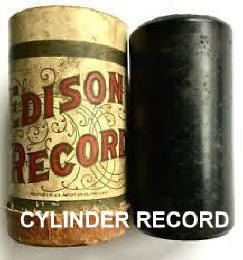 There
were many types of phonograph records produced by the
hundreds of millions from before 1900 up until the present. These took-on many
different appearances and designs, but in general:
There
were many types of phonograph records produced by the
hundreds of millions from before 1900 up until the present. These took-on many
different appearances and designs, but in general:-
Cylinders. Invented in 1877 by Thomas Edison and produced up until the late 1920's; the cylinder recording was the first commercial medium for recorded sound.
-
78 RPM Disc Records; invented by Emile Berliner in 1887, this became the dominant product for audio reproduction for many years. Note that there some disc recordings which operate at rotational speeds from 60 to 80 RPM, but 78 RPM became the 'standard' by the 1920's. There were several variants:
-
Early Rubber-Based Discs: these were typically small (7") single-sided records used on the earliest phonographs. Extremely fragile, and typically with high surface noise.
-
Shellac Discs: made from the late 1800's through the mid-1930's, these records could often be played on both sides, and ranged in diameter from 7" up to 14" or larger. These are also brittle and can be easily broken, but sound quality improved significantly after 1925 when electrical recording methods were introduced.
-
78 RPM Plastic-Compound Discs: made from the mid-1930's up until 1958. These records had an improved sound quality and less surface noise than their shellac predecessors, and were considerably less fragile. Plastic-based "78's'" became the primary medium for millions of Big-Band and popular vocal recordings through World War 2 and well into the 1950's. Came new with paper covers, although book-style albums containing several records packaged together were also popular
-
-
33-1/3 RPM Records; developed by Columbia Records in 1948, this quickly became known the "LP" or "vinyl" disc, and was the dominant media for recordings up through the 1990's. They were made in sizes ranging from 7" "singles" up to the standard 12" LP's. These are flexible discs, often with cardboard covers explaining the artist, etc.
-
45 RPM records; developed by RCA in 1949, these were originally intended to be a direct competitor to the "LP", but soon became used solely for inexpensive popular recordings through the 1980's. Usually flexible and often with a large center-hole.
-
-
Most of these record systems are not compatible. If you try to play a 1965 Dean Martin "LP" on a 1922 wind-up Victrola, it won't work. The Victrola will not operate at 33-1/3 RPM, and the weight of the stylus will crush the soft LP grooves. There are even compatibility problems between different types of '78s'. The 1940 and 1950 78 RPM records can also be damaged by the weight of the tonearm of an early Victrola. So all those Bing Crosby, Tommy Dorsey and Benny Goodman 78 RPM records you may have found in the attic are far too new to be used on an early acoustic (e.g. Victrola or Columbia) wind-up phonograph. And LP's (vinyl) records will be mangled beyond hope if you try to play them on an early Victrola.
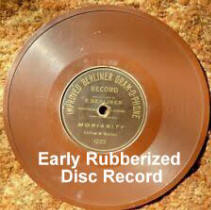
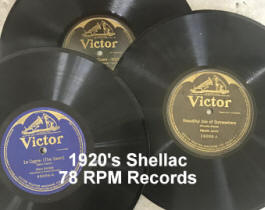
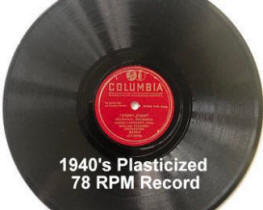
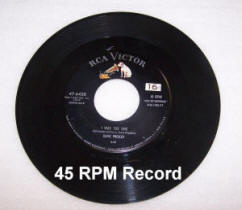
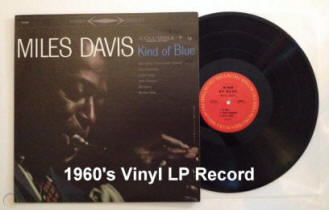
Value: Some experts have estimated that well over ONE HUNDRED BILLION phonograph records were made during the 20th Century. Hundreds of millions were sold in the 1900-1930 timeframe. Many have survived.
It is a fact that the vast majority of "old 78 RPM" records we come across are worth between 50 cents and $2.00 each (and often far less, depending on condition). Hundreds of thousands of early 78 RPM recordings survive today, and we often find them sold by the crates at swap meets and garage sales for a few bucks. Yes, there are some really rare and expensive titles out there and collectors pay big money for them. But they are not likely to be found mixed-in with grandpa's 1940's Frank Sinatra and Glenn Miller records. You may have seen a few valuable discs featured on TV shows, but just like finding a rare 17th Century book at the local library sale, the odds of finding a really rare record in your attic or at the swap meet are quite slim. Consider "Wheat Pennies"; there are millions of them still out there, but it is the very rare find that brings any money.
One may find 78's priced in the "$10.00" range at record shows and some swap meets. In most cases, the sellers purchased crates (or truckloads) of them from someone at far less than $1.00 each, threw out the broken/worn/damaged ones, sorted them, cleaned them up, graded them, and then marketed them at a retail level. The sellers obviously have to make some money out of the deal, but don't expect to get $10.00 each for most 78's that you have laying in the basement!
Unfortunately, we can't respond to any questions regarding the rarity or value of records, as we have no expertise in this subject
If you are new to the hobby and want to learn more, please return to the "GETTING STARTED" pages to guide you through the process of learning about your Victor Phonograph!
Rev 3 1-10-2021
